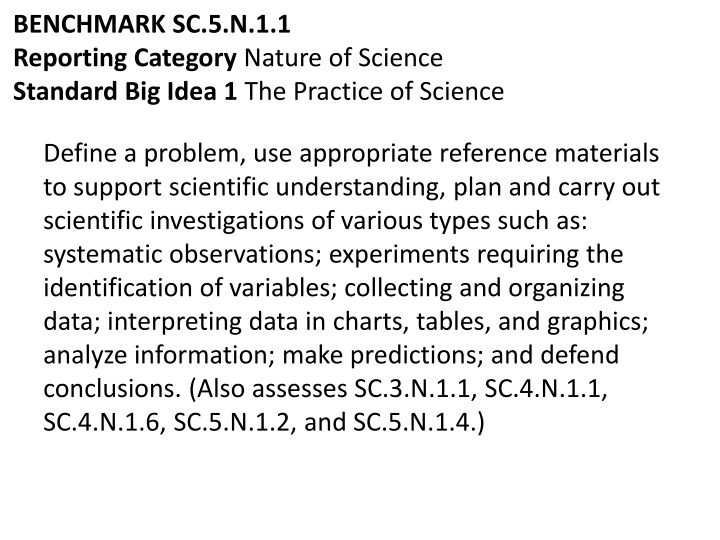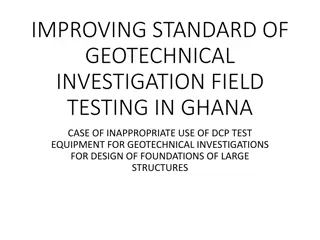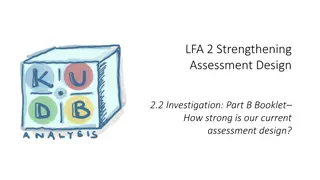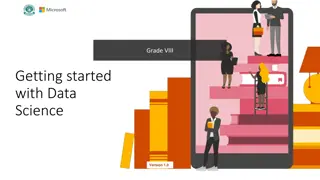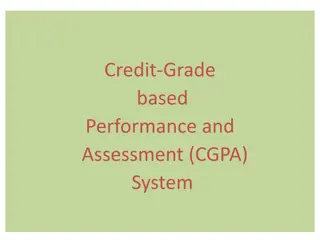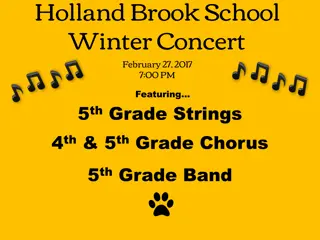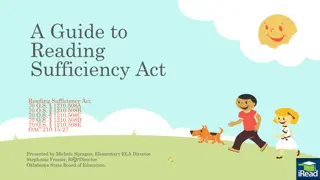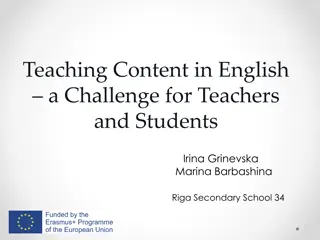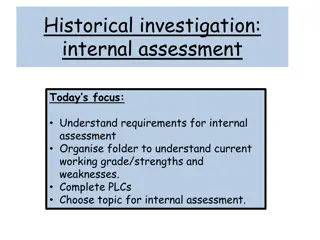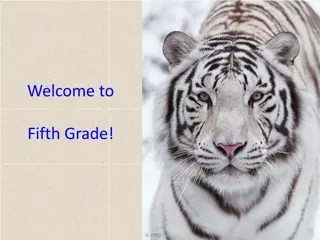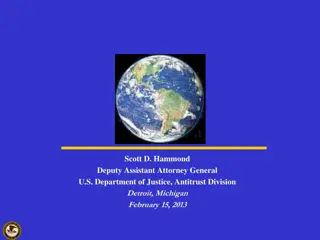Science Investigation Activities for Fifth Grade Students
Engage fifth-grade students in hands-on science investigations focused on defining problems, conducting experiments, analyzing data, and drawing conclusions. Explore topics related to magnets, metal objects, light sensitivity of earthworms, and the characteristics of scientific knowledge.
Download Presentation

Please find below an Image/Link to download the presentation.
The content on the website is provided AS IS for your information and personal use only. It may not be sold, licensed, or shared on other websites without obtaining consent from the author.If you encounter any issues during the download, it is possible that the publisher has removed the file from their server.
You are allowed to download the files provided on this website for personal or commercial use, subject to the condition that they are used lawfully. All files are the property of their respective owners.
The content on the website is provided AS IS for your information and personal use only. It may not be sold, licensed, or shared on other websites without obtaining consent from the author.
E N D
Presentation Transcript
BENCHMARK SC.5.N.1.1 Reporting Category Nature of Science Standard Big Idea 1 The Practice of Science Define a problem, use appropriate reference materials to support scientific understanding, plan and carry out scientific investigations of various types such as: systematic observations; experiments requiring the identification of variables; collecting and organizing data; interpreting data in charts, tables, and graphics; analyze information; make predictions; and defend conclusions. (Also assesses SC.3.N.1.1, SC.4.N.1.1, SC.4.N.1.6, SC.5.N.1.2, and SC.5.N.1.4.)
Sample Item 1 SC.5.N.1.1 Delilah followed these steps of an investigation: Collect five objects made of different types of metal. Place them on a large laboratory table. Touch each metal object with a magnet and lift slowly. Record observations. Which of the following statements is Delilah most likely testing? A. All types of metal are attracted to magnets. B. Each magnet can lift the metal object to the same height. C. Larger magnets can pick up heavier metal objects than smaller magnets can. D. Heavier metal objects are more attracted to magnets than lighter metal objects are.
Sample Item 1 SC.5.N.1.1 Delilah followed these steps of an investigation: Collect five objects made of different types of metal. Place them on a large laboratory table. Touch each metal object with a magnet and lift slowly. Record observations. Which of the following statements is Delilah most likely testing? A. All types of metal are attracted to magnets. B. Each magnet can lift the metal object to the same height. C. Larger magnets can pick up heavier metal objects than smaller magnets can. D. Heavier metal objects are more attracted to magnets than lighter metal objects are.
BENCHMARK SC.5.N.2.1 Reporting Category Nature of Science Standard: Big Idea 2 The Characteristics of Scientific Knowledge Recognize and explain that science is grounded in empirical observations that are testable; explanation must always be linked with evidence. (Also assesses SC.3.N.1.7, SC.4.N.1.3, SC.4.N.1.7, SC.5.N.1.5, and SC.5.N.1.6.)
Sample Item 2 SC.5.N.1.6 Rashan is performing an investigation using several earthworms. He places a rectangular box under a bright lamp and covers one-half of the box so that it is shaded. Then, he puts the earthworms into the box on the side that is still brightly lit. Later, Rashan notices that all of the earthworms have crawled over to the shaded side of the box. Based on his investigation, which of the following is an observation and NOT a personal opinion? A. Earthworms are afraid of light. B. Earthworms like staying together. C. Earthworms move away from light. D. Earthworms like living in the ground.
Sample Item 2 SC.5.N.1.6 Rashan is performing an investigation using several earthworms. He places a rectangular box under a bright lamp and covers one-half of the box so that it is shaded. Then, he puts the earthworms into the box on the side that is still brightly lit. Later, Rashan notices that all of the earthworms have crawled over to the shaded side of the box. Based on his investigation, which of the following is an observation and NOT a personal opinion? A. Earthworms are afraid of light. B. Earthworms like staying together. C. Earthworms move away from light. D. Earthworms like living in the ground.
BENCHMARK SC.5.N.2.2 Reporting Category Nature of Science Standard Big Idea 2 The Characteristics of Scientific SC.5.N.2.2 Recognize and explain that when scientific investigations are carried out, the evidence produced by those investigations should be replicable by others. (Also assesses SC.3.N.1.2, SC.3.N.1.5, SC.4.N.1.2, SC.4.N.1.5, and SC.5.N.1.3.)
Sample Item 3 SC.5.N.2.2 Gabriel is designing an experiment to see whether sugar or artificial sweetener will attract the greater number of ants. Which statement best describes why Gabriel should write down his experimental procedure? A. The exact experiment can be repeated by others and the results compared. B. The experiment can be changed by others to get different results. C. The data will help people decide what type of sweetener to use. D. The data will show people which ants are more common.
Sample Item 3 SC.5.N.2.2 Gabriel is designing an experiment to see whether sugar or artificial sweetener will attract the greater number of ants. Which statement best describes why Gabriel should write down his experimental procedure? A. The exact experiment can be repeated by others and the results compared. B. The experiment can be changed by others to get different results. C. The data will help people decide what type of sweetener to use. D. The data will show people which ants are more common.
BENCHMARK SC.5.E.5.1 Reporting Category Earth and Space Science Standard Big Idea 5 Earth in Space and Time SC.5.E.5.1 Recognize that a galaxy consists of gas, dust, and many stars, including any objects orbiting the stars. Identify our home galaxy as the Milky Way. (Also assesses SC.3.E.5.1, SC.3.E.5.2, and SC.3.E.5.3.)
Sample Item 4 SC.3.E.5.1 A star named Sirius appears as the brightest star in the nighttime sky, even though a star named Pollux actually gives off more light. Which of the following best explains why Sirius appears brighter than Pollux in our nighttime sky? A. Sirius has a different color than Pollux has. B. Sirius has different gases than Pollux has. C. Sirius is closer to Earth than Pollux is. D. Sirius is larger than Pollux is.
Sample Item 4 SC.3.E.5.1 A star named Sirius appears as the brightest star in the nighttime sky, even though a star named Pollux actually gives off more light. Which of the following best explains why Sirius appears brighter than Pollux in our nighttime sky? A. Sirius has a different color than Pollux has. B. Sirius has different gases than Pollux has. C. Sirius is closer to Earth than Pollux is. D. Sirius is larger than Pollux is.
BENCHMARK SC.5.E.5.3 Reporting Category Earth and Space Science Standard Big Idea 5 Earth in Space and Time SC.5.E.5.3 Distinguish among the following objects of the Solar System Sun, planets, moons, asteroids, comets and identify Earth s position in it. (Also assesses SC.5.E.5.2.)
Sample Item 5 SC.5.E.5.2 Jacob started creating a diagram to show some of the common characteristics of the planets in our solar system. See below. Which characteristic should Jacob write in the empty circle of the diagram? A. Made Mostly of Gas B. Has a Rocky Surface C. Revolves around a Star D. Is a Satellite of Another Planet
Sample Item 5 SC.5.E.5.2 Jacob started creating a diagram to show some of the common characteristics of the planets in our solar system. See below. Which characteristic should Jacob write in the empty circle of the diagram? A. Made Mostly of Gas B. Has a Rocky Surface C. Revolves around a Star D. Is a Satellite of Another Planet
BENCHMARK SC.4.E.5.4 Reporting Category Earth and Space Science Standard Big Idea 5 Earth in Space and Time SC.4.E.5.4 Relate that the rotation of Earth (day and night) and apparent movements of the Sun, Moon, and stars are connected. (Also assesses SC.4.E.5.1, SC.4.E.5.2, and SC.4.E.5.3.)
Sample Item 6 SC.4.E.5.3 Keisha wants to show Amy what happens during one Earth day. Keisha holds a small globe representing Earth, and Amy holds a large ball representing the Sun. What should Keisha do to show Amy what happens during one Earth day? A. Keisha should move the globe in one complete circle around Amy. B. Keisha should move the globe toward Amy and then away from her. C. Keisha should slowly lift the globe above her head and then lower it. D. Keisha should slowly spin the globe one complete time about its axis.
Sample Item 6 SC.4.E.5.3 Keisha wants to show Amy what happens during one Earth day. Keisha holds a small globe representing Earth, and Amy holds a large ball representing the Sun. What should Keisha do to show Amy what happens during one Earth day? A. Keisha should move the globe in one complete circle around Amy. B. Keisha should move the globe toward Amy and then away from her. C. Keisha should slowly lift the globe above her head and then lower it. D. Keisha should slowly spin the globe one complete time about its axis.
BENCHMARK SC.4.E.6.2 Reporting Category Earth and Space Standard Big Idea 6 Earth Structures SC.4.E.6.2 Identify the physical properties of common earth-forming minerals, including hardness, color, luster, cleavage, and streak color, and recognize the role of minerals in the formation of rocks. (Also assesses SC.4.E.6.1.)
Sample Item 7 SC.4.E.6.2 Dennis cannot scratch a mineral sample with his fingernail, but he observes that he can scratch the mineral sample with a piece of metal. What physical property of the mineral sample is Dennis investigating? A. cleavage B. hardness C. luster D. streak
Sample Item 7 SC.4.E.6.2 Dennis cannot scratch a mineral sample with his fingernail, but he observes that he can scratch the mineral sample with a piece of metal. What physical property of the mineral sample is Dennis investigating? A. cleavage B. hardness C. luster D. streak
BENCHMARK SC.4.E.6.3 Reporting Category Earth and Space Science Standard Big Idea 6 Earth Structures SC.4.E.6.3 Recognize that humans need resources found on Earth and that these are either renewable or nonrenewable. (Also assesses SC.4.E.6.6.)
Sample Item 8 SC.4.E.6.3 There are many different natural resources found in Florida. Which of the following can be described as a renewable resource? A. limestone B. oil C. phosphate D. water
Sample Item 8 SC.4.E.6.3 There are many different natural resources found in Florida. Which of the following can be described as a renewable resource? A. limestone B. oil C. phosphate D. water
SC.4.E.6.4 Reporting Category :Earth and Space Science Standard Big Idea 6 Earth Structures SC.4.E.6.4 Describe the basic differences between physical weathering (breaking down of rock by wind, water, ice, temperature change, and plants) and erosion (movement of rock by gravity, wind, water, and ice).
Sample Item 9 SC.4.E.6.4 Earth has a great variety of surface features that are caused by weathering and erosion. Which of the following describes a change due only to weathering? A. ocean waves washing sand off the beach B. rivers carrying soil and rocks through valleys C. wind blowing sand and pebbles off a sand dune D. tree roots breaking rocks into smaller pieces of rock
Sample Item 9 SC.4.E.6.4 Earth has a great variety of surface features that are caused by weathering and erosion. Which of the following describes a change due only to weathering? A. ocean waves washing sand off the beach B. rivers carrying soil and rocks through valleys C. wind blowing sand and pebbles off a sand dune D. tree roots breaking rocks into smaller pieces of rock
SC.5.E.7.1 Reporting Category: Earth and Space Science Standard Big Idea 7 Earth Systems and Patterns SC.5.E.7.1 Create a model to explain the parts of the water cycle. Water can be a gas, a liquid, or a solid and can go back and forth from one state to another. (Also assesses SC.5.E.7.2.)
Sample Item 10 SC.5.E.7.1 A model of the water cycle was made using an aquarium with a glass cover, a container of ice cubes, water, and a lamp. Which part of the water cycle causes the water droplets to form on the glass cover? A.condensation B.evaporation C.precipitation D.Runoff
Sample Item 10 SC.5.E.7.1 A model of the water cycle was made using an aquarium with a glass cover, a container of ice cubes, water, and a lamp. Which part of the water cycle causes the water droplets to form on the glass cover? A.condensation B.evaporation C.precipitation D.Runoff
SC.5.E.7.3 Reporting Category: Earth and Space Science Standard Big Idea 7 Earth Systems and Patterns Recognize how air temperature, barometric pressure, humidity, wind speed and direction, and precipitation determine the weather in a particular place and time. (Also assesses SC.5.E.7.4, SC.5.E.7.5, and SC.5.E.7.6.)
Sample Item 11 SC.5.E.7.6 Earth has many types of climate zones. The map below shows the tundra climate zones of the Northern Hemisphere. Which of the following best describes this type of climate zone? A. It is very hot because it is on the coastline. B. It is very wet because it is below sea level. C. It receives very little snowfall because it is close to the ocean. D. It has very cold temperatures because it is far from the equator.
Sample Item 11 SC.5.E.7.6 Earth has many types of climate zones. The map below shows the tundra climate zones of the Northern Hemisphere. Which of the following best describes this type of climate zone? A. It is very hot because it is on the coastline. B. It is very wet because it is below sea level. C. It receives very little snowfall because it is close to the ocean. D. It has very cold temperatures because it is far from the equator.
SC.5.P.8.1 Reporting Category: Physical Science Standard Big Idea 8 Properties of Matter SC.5.P.8.1 Compare and contrast the basic properties of solids, liquids, and gases, such as mass, volume, color, texture, and temperature. (Also assesses SC.3.P.8.1, SC.3.P.8.2, SC.3.P.8.3, and SC.4.P.8.1.)
Sample Item 12 SC.5.P.8.1 Kyle and Jan are comparing two samples of matter. They make a table of the properties of each sample. Which property provides the best evidence that both samples are solids rather than liquids? A. color B. mass C. shape D. volume
Sample Item 12 SC.5.P.8.1 Kyle and Jan are comparing two samples of matter. They make a table of the properties of each sample. Which property provides the best evidence that both samples are solids rather than liquids? A. color B. mass C. shape D. volume
SC.5.P.8.3 Reporting Category: Physical Science Standard Big Idea 8 Properties of Matter SC.5.P.8.3 Demonstrate and explain that mixtures of solids can be separated based on observable properties of their parts such as particle size, shape, color, and magnetic attraction. (Also assesses SC.5.P.8.2.)
Sample Item 13 SC.5.P.8.2 Dani adds 10 grams (g) of salt to a jar of water. She then adds 10 g of sand to a second jar of water. She covers and shakes both jars and sets them on the table for five minutes. The materials Dani uses are shown below. What should Dani expect to observe after those five minutes? A. Both the salt and the sand dissolved in the water. B. Both the salt and the sand settled to the bottom of the jar. C. The salt settled to the bottom of the jar, and the sand dissolved in the water. D. The salt dissolved in the water, and the sand settled to the bottom of the jar.
Sample Item 13 SC.5.P.8.2 Dani adds 10 grams (g) of salt to a jar of water. She then adds 10 g of sand to a second jar of water. She covers and shakes both jars and sets them on the table for five minutes. The materials Dani uses are shown below. What should Dani expect to observe after those five minutes? A. Both the salt and the sand dissolved in the water. B. Both the salt and the sand settled to the bottom of the jar. C. The salt settled to the bottom of the jar, and the sand dissolved in the water. D. The salt dissolved in the water, and the sand settled to the bottom of the jar.
SC.5.P.9.1 Reporting Category Physical Science Standard Big Idea 9 Changes in Matter SC.5.P.9.1 Investigate and describe that many physical and chemical changes are affected by temperature. (Also assesses SC.3.P.9.1 and SC.4.P.9.1.)
Sample Item 14 SC.3.P.9.1 One morning, Ryan noticed there were tiny drops of water on the grass as he walked to school. That afternoon, he did not see any drops of water on the grass when he returned home. Which of the following best explains what happened to the drops of water? A. The heat from the air caused the water drops to boil. B. The air cooled the water and caused the drops to freeze. C. The Sun heated the water and caused the drops to evaporate. D. The energy from the Sun caused the water drops to condense.
Sample Item 14 SC.3.P.9.1 One morning, Ryan noticed there were tiny drops of water on the grass as he walked to school. That afternoon, he did not see any drops of water on the grass when he returned home. Which of the following best explains what happened to the drops of water? A. The heat from the air caused the water drops to boil. B. The air cooled the water and caused the drops to freeze. C. The Sun heated the water and caused the drops to evaporate. D. The energy from the Sun caused the water drops to condense.
SC.5.P.10.1 Reporting Category Physical Science Standard Big Idea 10 Forms of Energy SC.5.P.10.1 Investigate and describe some basic forms of energy, including light, heat, sound, electrical, chemical, and mechanical. (Also assesses SC.3.P.10.1, SC.3.P.10.3, SC.3.P.10.4, SC.3.P.11.1, SC.3.P.11.2, SC.4.P.10.1, and SC.4.P.10.3.)
Sample Item 15 SC.4.P.10.3 Jason stretches a rubber band between his fingers, as shown below. When he plucks the rubber band, it makes a sound. Which of the following best explains why the rubber band makes a sound when Jason plucks it? A. It heats the air. B. It vibrates the air. C. It absorbs energy from the air. D. It releases molecules into the air.
Sample Item 15 SC.4.P.10.3 Jason stretches a rubber band between his fingers, as shown below. When he plucks the rubber band, it makes a sound. Which of the following best explains why the rubber band makes a sound when Jason plucks it? A. It heats the air. B. It vibrates the air. C. It absorbs energy from the air. D. It releases molecules into the air.
SC.5.P.10.2 Reporting Category Physical Science Standard Big Idea 10 Forms of Energy SC.5.P.10.2 Investigate and explain that energy has the ability to cause motion or create change. (Also assesses SC.3.P.10.2, SC.4.P.10.2, and SC.4.P.10.4.)
Sample Item 16 SC.4.P.10.2 Frank uses a bowling ball to demonstrate how energy can cause changes. Which of the following actions would NOT demonstrate a change caused by Frank applying energy to the ball? A. He holds the bowling ball in both hands. B. He spins the bowling ball with one hand. C. He rolls the bowling ball across the floor. D. He lifts the bowling ball to place it on a shelf.
Sample Item 16 SC.4.P.10.2 Frank uses a bowling ball to demonstrate how energy can cause changes. Which of the following actions would NOT demonstrate a change caused by Frank applying energy to the ball? A. He holds the bowling ball in both hands. B. He spins the bowling ball with one hand. C. He rolls the bowling ball across the floor. D. He lifts the bowling ball to place it on a shelf.
BENCHMARK SC.5.P.10.4 Reporting Category Physical Science Standard Big Idea 10 Forms of Energy SC.5.P.10.4 Investigate and explain that electrical energy can be transformed into heat, light, and sound energy, as well as the energy of motion. (Also assesses SC.3.E.6.1, SC.4.P.11.1, SC.4.P.11.2, SC.5.P.10.3, SC.5.P.11.1, and SC.5.P.11.2.)
